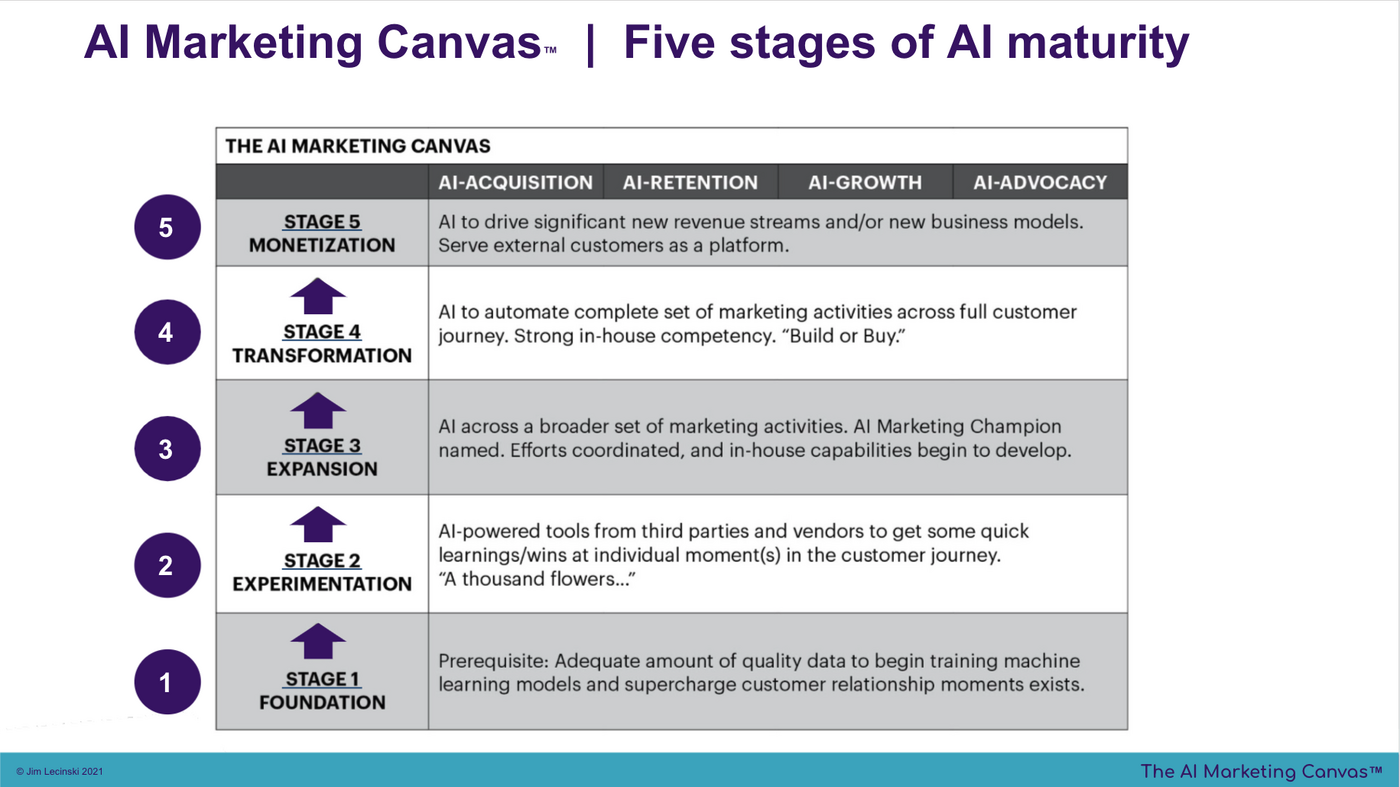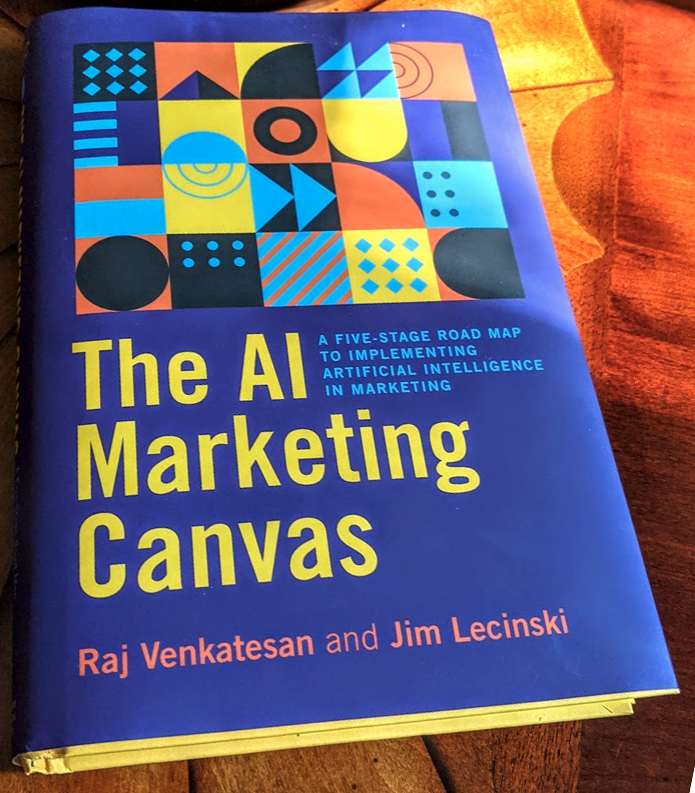Marketing Sep 3, 2021
Marketers: Stop Dragging Your Feet and Start Using AI
Speed is a competitive advantage. A coauthor of the new book “The AI Marketing Canvas” explains why—and how—to get started.

Michael Meier
In some respects, there has never been a better time for marketers to learn about their customers. The amount of data available to companies can help them keep tabs on how well their initiatives are working; experiment with new products, services, or delivery methods; or find new sources of growth. But the large amount of data is less likely to be effective if you don’t have a plan for putting it to use.
In their new book, The AI Marketing Canvas: A Five Stage Roadmap to Implementing Artificial Intelligence in Marketing, Raj Venkatesan of the University of Virginia and his coauthor Jim Lecinski, a clinical associate professor of marketing at the Kellogg School, lay out an action plan for chief marketing officers to plan and implement a sustainable AI-driven marketing function within their organizations.
Kellogg Insight recently spoke with Lecinski about the growth opportunities companies are missing if they don’t incorporate AI and machine learning into their marketing strategy, what keeps companies from getting started, and how doing so may be less intimidating than you think.
Editor’s note: This interview has been edited for length and clarity.
KELLOGG INSIGHT: What are companies missing if their marketing strategy fails to incorporate machine learning or AI?
Jim LECINSKI: Machine learning can be used for efficiency or optimization gains. So, for example, any rote reporting could be automated and done more efficiently. Then those full-time employees could be repurposed and reapplied to other strategic growth projects.
More important is AI’s ability to drive growth. More and more, CEOs, boards, and marketing departments are viewing marketing as being the chief growth engine charged with making informed-by-data predictions or projections to find the optimal combination of the right product at the right price, promoted in the right way via the right channels to the right people. Big data plus machine learning can, in many cases, make those predictions and drive growth better than humans without data or humans merely assisted by data.
In our research for the book, we found that only about half of companies are doing anything at all related to machine learning in marketing, so a lot of companies are missing that growth. And if that’s the core function of marketing, then they’re delivering suboptimally on the core remit from the CEO, the board, shareholders, and stakeholders.
INSIGHT: It’s interesting that so many firms are leaving so much growth on the table. How can individual companies identify what they stand to gain, assuming that’s going to be different for every company?
LECINSKI: The strategic question for a company’s marketing leader to ask is, “What is it about my business, my brand, my marketing that—if I were able to predict it with much greater fidelity—would unlock a step change in growth?” The answer is different for every kind of accompany.
Let me unpack a couple of possible use cases for this. In the B2B space, marketing is largely informed by an in-person, white-glove sales force. So in pre-COVID days, marketers would have to get in the car, get on the plane, and go see the customers or prospects. The sales team can only make so many sales calls a week. Whom should they go talk to? When they get there, what product or service should they pitch? And then how should they talk about it? That’s a three-level prediction you have to make in order to optimize the return on your white-glove sales team.
With AI, we can use data inputs to intuit several things: Which customers have the biggest marketing budget, which ones are growing the fastest, which ones have the biggest company size, which ones are located near me, and who will take my phone call? Then we could look at some of their firmographics, like what industry they are in and what kind of needs they might have, and then try to match that back to our products. By using machine learning to predict whom you should go talk to and what you should say to them, you could focus your limited-resource, white-glove-expert sales team on the best prospects.
Now consider product development. Wasabi and sriracha are the current hot flavors, but at some point, a food scientist working with a marketing team had to figure that out. In the past, marketers went out and looked for trends. They conducted surveys, focus groups, tastings at the mall. And then they picked the one that seemed to be most popular and commercialized that for next year’s hot-sauce flavor. But machine learning can look at everything that everyone is searching for or posting about on social media to make a prediction as to what the next hot-flavor trend might be.
Greek yogurt, of course, has taken over as the dominant flavor of yogurt. But it wasn’t always that way. The French-style yogurt with the fruit on the bottom used to be dominant. Well, if you go back and look at Google Search query volume, you can see that there was a breakout period when people started searching much more for Greek yogurt than for any other flavor of yogurt. Chobani saw that and now Chobani’s the market-share leader.
You don’t want to be the next company to miss a trend like that.
INSIGHT: So how can companies get started?
LECINSKI: There’s a widespread misperception that in order to use machine learning in marketing, you have to go from zero to a hundred right away. So that means you go hire an entire floor of Stanford or McCormick PhD data scientists who do everything bespoke for you. They build your own models, write your own code, and so on. But that’s not a best practice. That’s in some sense a last step once you’ve proven your way in and gotten started. My coauthor and I found in talking to a lot of companies at various stages of maturity and experience that you need to start by getting started. Pick a challenge—what is it that, if I could predict it better, could unlock some business results—and then go try it.

Trying it usually means that you work initially with one of your existing business partners. If I’m working with a CRM company like Salesforce, or a media company like Google or Facebook, or an email provider like ExactTarget or MailChimp, all of these companies have machine-learning-powered solutions for what you are already doing. It doesn’t take a big budget and a head count of data scientists to get started. Just go talk to your partners and say, “Hey, we’re sending out emails every week. Is there a way to optimize that in terms of deciding what the subject line should say or what the content of that email is, who should receive it, when they should get it?”
INSIGHT: It seems that some of the low-hanging fruit, those easy, early wins, can also be relatively inexpensive. And then the further along you get in the process of incorporating machine learning into your marketing function, the required investment goes up. Is that a place where some stakeholders might lose patience? In your experience, what internal concerns hold companies back from a deeper investment into an AI-driven marketing function?
LECINSKI: There are four concerns that we regularly hear about. The first is a basic lack of awareness and knowledge. Most marketers didn’t grow up through the marketing function as technologists or data experts. Many marketers were attracted to the field from the creative aspect, the inspirational aspect, the consumer-insight aspect of this. If the technology part is not your background or your orientation, you might not be aware of how much marketing is being transformed, under our eyes. And if you are aware, you might not have the technical comfort level or training or competence to be able to know how to do this.
The second barrier is that the responsibility for marketing-technology decisions is often delegated to the CIO or the CTO in a company. And those tech folks are often working on other massive, enterprise-wide, multiyear data-integration transformations. So you may want to bring AI and machine learning into the marketing function, but your CTO may be telling you that you can’t do it for a couple of years.
The third barrier is that there’s often concern about the potential downsides to transformation. When we’re talking about marketing on a personalized, individualized, one-to-one level, there are questions about data privacy, data protection, and bias. As humans, we more easily foresee the negatives or the downsides of any new technology. The upsides are less readily and immediately apparent. For instance, it’s easier to see that if everybody starts using Uber, all those cab drivers will be out of work, versus all the new business models that could result from ride-sharing technology.
The fourth barrier is expense. If I’m being asked every year to do more with less, my budget gets cut, and I can’t go ask for a head count of a thousand data scientists on the fifth floor; it gets tough to implement. That one’s a little ironic, because doing this right can make the company more efficient.
INSIGHT: So as inevitable as AI-driven marketing may seem, the urgency to do it immediately is often lacking.
LECINSKI: That’s fair to say. And it is shortsighted. In many human endeavors, we now see that speed is a competitive advantage. We saw how delivery went from, “Oh, look how amazing. I can get this on my porch in three days,” to overnight, to the next hour.
Well, if you have a system where a machine can optimize in real time for the best product, place, price, and messaging on a personalized, one-to-one basis, all while you and I are sleeping, you can see how a marketing function that operates that way will beat the marketing function that has a Friday standing staff meeting, where they look at a spreadsheet of the past week’s results and decide what to change for next week.
Fred Schmalz is the business and art editor of Kellogg Insight.




